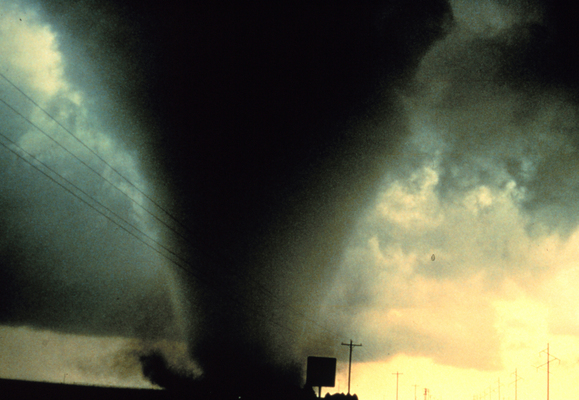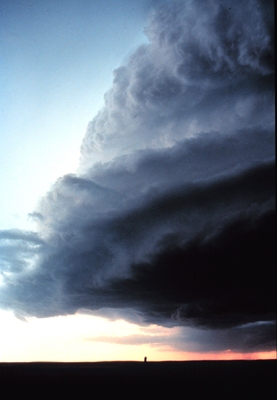
by Alexandra Ossola Thursday, January 5, 2012

A tornado such as this one is more likely to form if the storm produces larger precipitation, such as raindrops or hailstones. NOAA

The most violent tornados stem from massive supercell thunderstorms, such as this one. NOAA
A huge thunderstorm was gathering above central Oklahoma on May 20, 1977. As the storm intensified, a tornado began to form and struck the ground, leaving wreckage in its path. Although the tornado itself is now well-known, the forces behind its formation are still surprisingly sketchy. Using high-resolution modeling, however, a new study reveals how some atmospheric conditions can make tornadoes more — or less — likely to form.
Understanding the inner workings of a tornado has sometimes been a problem of scale, says Nathan Snook, a graduate research assistant at the University of Oklahoma in Norman. “In the past, [scientists] had to just look at tornados in detail or a whole storm in coarser grade,” Snook says. But he and Ming Xue, a meteorologist also at the University of Oklahoma, were able to look at a whole storm in finer detail, using a weather modeling program called the Advanced Regional Prediction System to plot the temperature, air pressure and moisture at different locations in a storm on a 3-D grid.
These different atmospheric conditions are important because they affect the strength of forces that make a storm more or less destructive, such as wind and precipitation. Air temperature, for example, has a huge effect on the formation of a tornado. Tornadoes form from supercells when spiraling, warm, moist air near the ground begins to be tilted vertically by the updraft of the storm. As this column spirals faster in the cloud, a “wall cloud” begins to extend down from the cloud towards the ground.
So Xue and Snook plotted the microphysical conditions — atmospheric conditions at the atomic or molecular scale — leading to the 1977 tornadic supercell that struck Del City. “We wanted to see how model microphysics keeps track of what’s going on in the cloud and how the model handles different properties like snow, hail and rain,” Snook says. For example, they created multiple simulations to test the effects of small raindrops versus large raindrops, or small hailstones versus large hailstones.
They found that drop size influences the air temperature under the cloud. “Large raindrops don’t evaporate as quickly because they have a smaller surface area relative to their volume," Snook says. Also, he adds, "they are more concentrated in a small area because they don’t blow around as much." Evaporation cools the air — so when there are larger raindrops and less evaporation, the air is warmer under a storm cell. With smaller raindrops and colder air under the cloud — called a “cold pool” — “the cold air goes in front of the storm and stops tornado development,” Snook says.
Xue and Snook’s results are consistent with other research on tornado formation, says Bill Cotton, a professor of atmospheric science at Colorado State University in Fort Collins, Colo. Cotton says that his team got similar results, “but for different reasons” — Cotton found that aerosols from pollution inhibited the formation of rain in clouds, which in turn made the cold pool weaker. As a result, he found, tornadoes formed more readily.
These new discoveries, which were published recently in Geophysical Research Letters, could ultimately make tornadoes more predictable by finding the conditions under which they are more likely to form — but they have yet to be tested in the field, Snook says. “Observational studies have found that tornadoes require warmer air beneath storm. We need more observational confirmation.”
Cotton notes that more modeling needs to be done as well. “We need to examine a lot of different cases to see how important these effects are,” he says. In the future, models should incorporate even more factors that would change the likelihood of tornado genesis, he says. “This cold pool thing is one of many factors that affect the tornado formation. There are many more to be looked at."
© 2008-2021. All rights reserved. Any copying, redistribution or retransmission of any of the contents of this service without the expressed written permission of the American Geosciences Institute is expressly prohibited. Click here for all copyright requests.